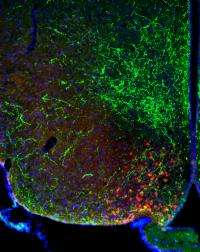How to get obese mice moving -- and cure their diabetes

Mice lacking the fat hormone leptin or the ability to respond to it become morbidly obese and severely diabetic—not to mention downright sluggish. Now, a new study in the June Cell Metabolism shows that blood sugar control in those animals can be completely restored by returning leptin sensitivity to a single class of neurons in the brain, which account for only a small fraction of those that normally carry the hormone receptors.
"Just the receptors in this little group of neurons are sufficient to do the job," said Christian Bjorbaek of Harvard Medical School.
What's more, animals with leptin receptors only in the so-called pro-opiomelanocortin (POMC) neurons spontaneously increase their physical activity levels despite the fact that they remain profoundly obese. While understanding exactly how the POMC neurons act on other organs remains a future challenge, the discovery suggests that drugs designed to tap into the pathway—turning up or down the dial, so to speak—might have benefit for those with severe diabetes and obesity, according to the researchers.
Such drugs might even encourage obese individuals to get moving. "This gives us the opportunity to search for drugs that might induce the desire or will to voluntarily exercise," Bjorbaek said.
Leptin was first identified 15 years ago and made famous for its ability to curb appetite and lead to weight loss. It is known to play a pivotal role in energy balance through its effects on the central nervous system, specifically by acting on a hypothalamic brain region known as the arcuate nucleus (ARC). The ARC contains two types of leptin-responsive neurons, the POMC neurons, which cause a loss of appetite, and the so-called Agouti-related peptide (AgRP) neurons, which do the opposite.
Studies had also revealed a role for leptin in blood sugar control and activity level, also via effects on the ARC. However, scientists still didn't know which neurons were responsible, until now.
When the researchers restored leptin receptor activity in POMC neurons of otherwise leptin-resistant, obese, and diabetic mice, the animals began eating about 30 percent fewer calories and lost a modest amount of weight. Remarkably, the researchers report, their blood sugar levels returned to normal independently of any change in their eating habits or weight. The animals also doubled their activity levels.
Whether this particular bunch of neurons also plays a similarly important role in animals that are lean remains uncertain, Bjorbaek said. "It may be that in the context of severe obesity and diabetes, these neurons do something they don't normally do," he said. But, he added, even if that were the case, it may not matter when it comes to its potential as a therapeutic target.
Source: Cell Press (news : web)















